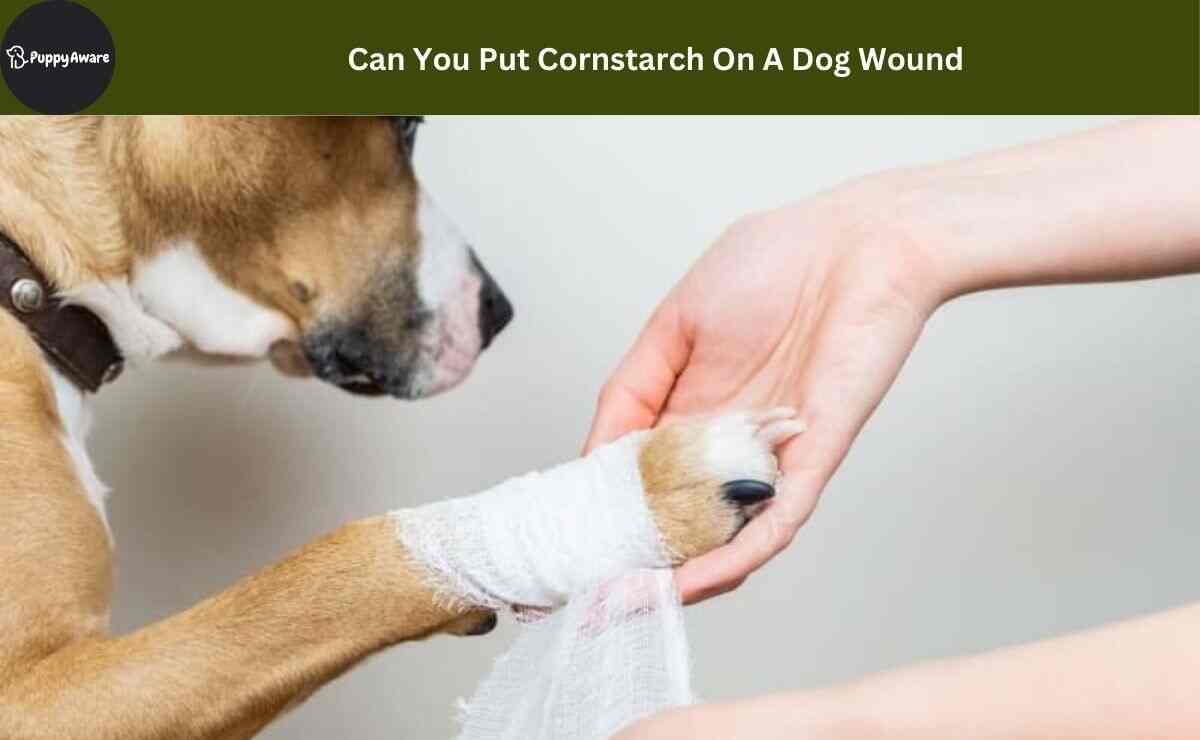If your dog gets injured, then how you will treat the wound? Like many others you may think, can you put cornstarch on a dog wound?
When it comes to treating a dog wound, it is important to consult with a veterinarian before taking action. However, many prefer home remedies.
Though there is observance of using cornstarch to control bleeding, it is not recommended to use cornstarch on a dog wound without proper guidance. To know the right solution for treating dog wounds, read on throughout the post.
Can You Put Cornstarch On A Dog Wound?

Cornstarch is a food product made from corn that has thickening properties. People use it as a temporary solution to stop minor bleeding by applying it directly to the wound. However, dogs have different physiological responses, and certain substances that are safe for humans may not be safe for dogs.
Cornstarch doesn’t have blood clotting agents. So it can’t effectively treat the wound, rather it can cause irritation and infection on the skin. Also, it badly sticks to the wound and later, makes it difficult to remove and clean.
Yet, only in one case, you can use cornstarch on a dog. After an unintentional nail trim mishap, if bleeding does not stop from the nail tip.
Usually, veterinarians rely on styptic sticks to immediately halt bleeding from trimmed nails. If you have one handy, apply gentle pressure to the injured nail’s tip for a few minutes until the bleeding subsides.
In case you don’t have a styptic stick, don’t worry. Instead, you can use cornstarch or flour. Simply take a small amount on your fingertip and press it onto the bleeding nail.
The cornstarch thickening agent will stick to the nail. Within a few duration, the bleeding should stop. Maintain light pressure until the bleeding seems to have ceased. Avoid bandaging your dog’s paw, as it may hinder normal walking.
Since the nail tip is a hard area, so there is less chance of infection than the skin. Cornstarch will be a good alternative to styptic sticks.
Does Cornstarch Stop Bleeding in Dogs?
Cornstarch is not an effective remedy for stopping bleeding in dogs. It might appear to be a quick fix, but it can lead to skin irritation and discomfort for your dog. If you notice bleeding from a cut or wound, refrain from using cornstarch.
For a more reliable and safe approach, opt for products explicitly specialized for this purpose, such as styptic powder.
These specialized solutions are formulated to swiftly and securely stop bleeding, minimizing the risk of infection. When caring for your pup, it’s always wise to rely on these products.
When dealing with bleeding, avoid the temptation to use cornstarch. It’s an ineffective solution that may harm your pup’s skin. Instead, opt for a pressure bandage using a clean cloth or gauze.
For deeper wounds, you must seek professional veterinary care for proper treatment. Avoid the use of cornstarch, as it not only proves ineffective but may also pose risks to your dogs.
What To Do After A Dog is Wounded Or Injured?
If your dog gets injured, you need to take necessary actions to prevent infection and promote healing. Here are some tips:
- Swift action is key when your dog has an injury. If the wound is bleeding, promptly apply pressure using a clean cloth or gauze. Maintain this pressure for a minimum of 5 minutes until the bleeding reduces.
- Once the bleeding is under control, proceed to clean the wound. Utilize a sterile saline solution or clean water for this purpose. Steer clear of using hydrogen peroxide or alcohol, as these substances can cause additional harm to the tissue.
- After cleaning, safeguard the wound from potential contamination. So cover it with a sterile bandage or gauze. However, be cautious not to wrap the bandage too tightly, as it could impede blood flow. This basic bandaging serves as a temporary shield.
Use Antibiotic Ointments
For treating dog wounds, antibiotic ointments are a popular choice for dog owners. These ointments are suitable for preventing infections and fostering the healing process.
Before applying, ensure a thorough cleaning of the wound. Follow this by gently applying a thin layer of the chosen ointment and covering it with a bandage for added protection.
These commonly used options not only prevent infections but also contribute to the healing process.
Natural Remedies For Dog’s Wounds
- Honey
For centuries, honey has been popular for its therapeutic properties. It also emerges as a natural remedy for various dog wounds. Packed with beneficial compounds like flavonoids and vitamins, honey has healing power.
Recent studies, such as those from NCBI, endorse its effectiveness in treating burns and scratches. Dog owners can harness the power of honey to naturally combat bacteria and support speedy healing.
- Turmeric
Natural turmeric compound curcumin has been recognized as a powerful healer for centuries. Recent studies highlight its ability to reduce inflammation, clear harmful particles, and enhance wound recovery by stimulating collagen growth.
Overcoming challenges of solubility and metabolism, modern science explores nanotechnology for targeted delivery, maximizing curcumin’s effectiveness in wound care.
- Aloe Vera
Aloe Vera stands as a natural remedy with remarkable benefits for treating dog wounds. It has anti-inflammatory properties and proves effective in soothing the skin and promoting healing.
To begin, cut a fresh aloe vera leaf and extract the gel carefully. The gel holds the key components that contribute to its healing properties.
Apply the extracted aloe vera gel directly to the wound. The anti-inflammatory nature of aloe vera helps alleviate discomfort and supports the healing process. After applying the gel, cover the wound with a bandage.
- Colloidal Silver
As a natural antibiotic, colloidal silver aids in preventing infection and promoting healing. Apply a small amount directly to the wound and cover it with a bandage.
Change the bandage and reapply colloidal silver twice daily until the wound heals. While some studies question its efficacy, diligent research is advisable before incorporating colloidal silver into your dog’s wound care routine.
- Calendula
Marigold, or calendula, is a Mediterranean plant renowned for healing wounds and reducing inflammation. Research studies, especially those testing calendula extracts from Brazil, highlight its role in supporting skin repair.
Calendula reduces inflammation and fights bacteria band aids and blood vessel formation, fostering the skin’s healing process. A promising natural remedy for wound care and recovery.
When To Seek A Veterinarian?
Though you don’t need to go to a vet for a minor cut, you should be aware of the infection and its severity. So here are some situations when you need to consult a vet.
Deep and Heavy Bleeding: If the wound is deep and bleeding extensively, immediate veterinary attention is crucial. Profuse bleeding may signify a more serious injury that requires professional care.
Proximity to Sensitive Areas: Wounds located near the eye or on the face demand special attention. Given the sensitivity of these areas, seeking veterinary help ensures proper care and prevents potential complications.
Signs of Infection: Watch for signs of infection such as redness, swelling, or discharge from the wound. These indicators warrant veterinary intervention to prevent the infection from spreading and affecting your dog’s overall health.
Severe Pain or Discomfort: If your dog exhibits signs of severe pain or discomfort associated with the wound, it’s a clear signal to consult with a veterinarian. They can assess the pain level and prescribe appropriate relief.
Lethargy or Signs of Illness: A lethargic demeanor or general signs of illness in your dog could be linked to the wound. Seeking veterinary help ensures a comprehensive evaluation to address both the wound and any underlying health issues.
If your dog has any of these signs, it’s highly recommended to take your dog to a veterinarian promptly. Delaying treatment may lead to complications and exacerbate your dog’s condition.
Conclusion
It is only advisable to use cornstarch on a dog wound for limited cases. However, you can apply it if there is bleeding from the nail tip while trimming nails, still, it needs proper care.
Avoid applying it on wounds of the skin. It won’t be effective rather it can cause infection and irritation.
